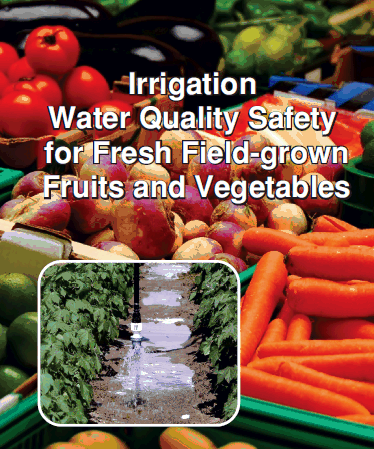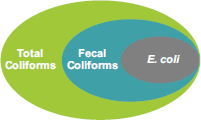| |
 The quality of irrigation water in Alberta is some of the best in the world, owing to the fact that it is derived from snowmelt in the Rocky Mountains. Nonetheless, all surface water, including irrigation water, is susceptible to contamination with fecal pathogens that have the potential to cause foodborne illness in humans. While there have been no reported incidences of foodborne illness linked to irrigation water for produce grown in Alberta, such outbreaks have occasionally been associated with produce originating from Mexico and the USA. The quality of irrigation water in Alberta is some of the best in the world, owing to the fact that it is derived from snowmelt in the Rocky Mountains. Nonetheless, all surface water, including irrigation water, is susceptible to contamination with fecal pathogens that have the potential to cause foodborne illness in humans. While there have been no reported incidences of foodborne illness linked to irrigation water for produce grown in Alberta, such outbreaks have occasionally been associated with produce originating from Mexico and the USA.
Water Testing: Surface Water Quality Guidelines
According to the Surface Water Quality Guidelines for use in Alberta, water used to irrigate crops should contain no more than 100 fecal coliforms per 100 mL water.
If there are indications that irrigation water may exceed the guideline, growers should use extra precaution to ensure that the irrigated produce being grown is safe for consumers.
Is Irrigation Water Quality Being Monitored?
Alberta Agriculture and Rural Development in partnership with the irrigation districts, Alberta Irrigation Projects Association, and Alberta Irrigation Council have initiated a study (2011-2015) to assess the quality of irrigation water. A number of water quality parameters are being assessed including nutrients, salinity, metals, fecal coliforms, and pesticides. For more information see “Irrigation Districts Water Quality Project”
What are Pathogens and Where Do They Come From?
Pathogens are disease-causing microorganisms, like bacteria and viruses.
Pathogens can be introduced into irrigation water through runoff of manure from livestock operations, malfunctioning
septic systems that release human sewage, or from wildlife and other animals that have direct access to water.
What are Coliforms and E. coli?
They are bacteria that are found naturally in the intestines of warm-blooded animals and humans, and are excreted in fecal matter. Detection of these bacteria in water is used to indicate fecal contamination. The bacteria are not necessarily harmful to humans, however, their presence indicates that fecal pathogens may be present.
 Total Coliforms - a general group of bacteria that can be found in the intestines of animals and in other environments. They are not a specific indicator of fecal contamination. Total Coliforms - a general group of bacteria that can be found in the intestines of animals and in other environments. They are not a specific indicator of fecal contamination.
Fecal coliforms - a sub-set of the total coliforms. These bacteria are predominantly found in the intestines of warm-blooded animals, and indicate fecal contamination.
E. coli - a single species of bacteria, and is a type of fecal coliform. E. coli is found only in the intestines of warm-blooded animals and is the most reliable indicator of fecal contamination in water. There are more than 1000 different strains of E. coli, most of which do not cause disease. E. coli O157:H7 is a particular strain that can cause foodborne illness.
Market Garden Food Safety
There are a number of precautions that can be taken to minimize pathogen contamination risks with produce from the field to the plate. Growers, processors, and consumers all have a role.
Market Growers
- Ensure that irrigation water is protected from fecal contamination by limiting access of wildlife and domestic animals, and by locating manure piles at a safe distance.
- Use drip irrigation for crops with higher risk of contamination such as lettuce, strawberries, or green onions which are consumed raw and are in contact with the ground or have large surface areas.
During the Growing Season
- Keep detailed records such as irrigation schedules, harvesting times, and water test results, as this information may be useful in the event of an outbreak of foodborne illness.
- Ensure field labourers wash hands with soap and water before and after handling produce.
- If manure is used to fertilize crops, ensure that it is well composted and has minimal contact with the crop to be consumed.
At Harvest
- Maximize the amount of time between the last irrigation and harvest as exposure to sunlight and dry conditions may kill the pathogens.
- Use potable treated water to wash produce.
- Ensure produce is thoroughly dry prior to packaging, since pathogens multiply in moist environments.
At Market
- Encourage consumers to wash produce prior to consumption.
Alberta Farm Fresh Products
In comparison to commercial vegetable producers, market gardeners are small scale producers who develop their own markets and sell all of their produce directly to consumers during the growing season
- More than 25 different kinds of fruits and vegetables are grown in Alberta for sale through farmers' markets and commercial markets including packers, wholesalers, retailers and restaurants
- Alberta has more than 130 Alberta Approved Farmers' Markets that are located in approximately 100 communities across the province
Where Do I Get More Information?
Information about Alberta's Approved Farmers' Markets
Canadian Food Inspection Agency information about pathogens that cause foodborne illness
Surface Water Quality Guidelines for use in Alberta
A list of accredited laboratories in Alberta that can test for fecal coliforms and E.coli
For other inquiries, please contact
Lisa Tymensen
Analytical Water Research Scientist
Irrigation and Farm Water Division
Phone: 403-381-5165
email: lisa.tymensen@gov.ab.ca |
|